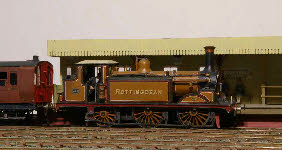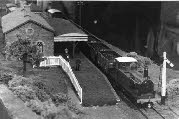



Last updated July 2014
 West Chiltington was first seen on the exhibition circuit in 1983. Its last exhibition
was in March 2000 at the Crawley Model Show. It has now passed to one of the members
of the group who has extended it and rebuilt it as a modern image layout. The notes
below, and the photographs, describe the layout in its original condition.
West Chiltington was first seen on the exhibition circuit in 1983. Its last exhibition
was in March 2000 at the Crawley Model Show. It has now passed to one of the members
of the group who has extended it and rebuilt it as a modern image layout. The notes
below, and the photographs, describe the layout in its original condition.
Our model of West Chiltington was based on typical "Brighton" practice in its hey-
 All of the structures are accurate copies of Brighton prototypes: for example, the
station building comes from Burgess Hill; the signal box from Ardingly; the goods
shed from Rotherfield; the cattle creep from Culver Junction .... and so on. The
buildings were all scratchbuilt using a variety of materials, principally card and
plasticard. All brickwork was hand-
All of the structures are accurate copies of Brighton prototypes: for example, the
station building comes from Burgess Hill; the signal box from Ardingly; the goods
shed from Rotherfield; the cattle creep from Culver Junction .... and so on. The
buildings were all scratchbuilt using a variety of materials, principally card and
plasticard. All brickwork was hand-
 The techniques used to build it have shown the test of time, even if they are now
a bit dated. For example, trackwork was entirely handbuilt using plywood sleepers
and rivets. Solenoids were used for turnout operation. Signals were handbuilt, and
also used solenoids for operation. The layout comprised a central scenic section,
16ft long by just 1ft wide. Four-
The techniques used to build it have shown the test of time, even if they are now
a bit dated. For example, trackwork was entirely handbuilt using plywood sleepers
and rivets. Solenoids were used for turnout operation. Signals were handbuilt, and
also used solenoids for operation. The layout comprised a central scenic section,
16ft long by just 1ft wide. Four-
Rolling stock is from the period 1900-
We have very few good pictures of West Chiltington. Does any body else have any?
Please e-
West Chiltington









